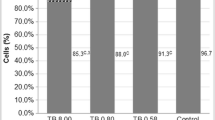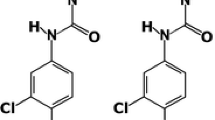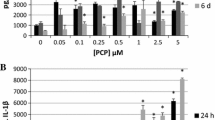Abstract
Objective: Evaluate peripheral blood lymphocyte proliferation (replicative index:RI) and micronuclei frequency (MF) among 2,4–D herbicide applicators.
Methods: Twelve applicators spraying only 2,4–D provided a blood and urine specimen upon enrollment, several urine samples during the spraying season, and a blood specimen at the study's end. Nine controls provided blood and urine specimens upon enrollment and at the study's end. Gas chromatography/tandem mass spectroscopy determined urinary 2,4–D levels and standard in-vitro assays determined RI and MF scores. Applicator RI and MF were compared before and after spraying and with controls.
Results: Applicators contributed 45 urine specimens with concentrations ranging from 1.0 to 1700 (μg 2,4–D/g creatinine/L urine) that logarithmically (ln) increased as spraying time increased. Applicator RI increased after spraying (p = 0.016), independent of tobacco and alcohol use, and demonstrated a weak dose-response with increasing urinary 2,4–D levels (p = 0.15). Among 2,4–D applicators, pre-exposure complete blood counts and lymphocyte immunophenotypes were not significantly different from post-exposure measurements.
Conclusion: Urinary 2,4–D concentration, an exposure biomarker, may be associated with lymphocyte replicative index, a cell proliferation biomarker.
Similar content being viewed by others
References
IARC (1991) 2,4–D and Esters. IARC Monographs on the Evaluation of the Carcinogenic Risk of Chemicals to Man. Geneva: World Health Organization, vol. 53.
Munro IC, Carlo GL, Orr JC, et al. (1992) A comprehensive integrated review and evaluation of the scientific evidence relating to the safety of the herbicide 2,4–D. J Am Coll Toxicol 11: 561–664.
Hoar SK, Blair A, Holmes FF, et al. (1986) Agriculture herbicide use and risk of lymphoma and soft-tissue sarcoma. JAMA 256: 1141–1147.
Zahm SH, Weisenburger DD, Babbitt PP, et al. (1990) A case-control study of non-Hodgkin's lymphoma and the herbicide 2,4–dichlorophenoxyacetic acid (2,4–D) in eastern Nebraska. Epidemiology 1: 349–356.
Wigle DT, Semenciw RM, Wilkins K, et al. (1990) Mortality study of Canadian male farm operators: non-Hodgkin's lymphoma mortality and agricultural practices in Saskatchewan. J Natl Cancer Inst 82: 575–582.
Bond GG, Wetterstroem NH, Roush GJ, McLaren EA, Lipps TE, Cook RR (1988) Cause specific mortality among employees engaged in the manufacture, formulation, or packaging of 2,4–dichlorophenoxyacetic acid and related salts. Br J Ind Med 45: 98–105.
Cantor KP, Blair A, Everett G, et al. (1992) Pesticides and other agricultural risk factors for non-Hodgkin's lymphoma among men in Iowa and Minnesota. Cancer Res 52: 2447–2455.
Woods JS, Polissar L, Severson RK, Heuser LS, Kulander BG (1987) Soft tissue sarcoma and non-Hodgkin's lymphoma in relation to phenoxyherbicide and chlorinated phenol exposure in western Washington. J Natl Cancer Inst 78: 899–910.
Oakes DJ, Pollack JK (1999) Effects of a herbicide formulation, Tordon 75D, and its individual components on the oxidative functions of mitochondria. Toxicology 136: 41–52.
Blakely BB, Blakely PM (1986) The effect of prenatal exposure to the n-butylester of 2,4–dichloro-phenoxyacetic acid (2,4–D) on the immune response in mice. Teratology 33: 15–20.
Clausen M, Leier G, Witte I (1990) Comparison of the cytotoxicity and DNA-damaging properties of 2,4–D and U 46 fluid (dimethy-lammonium salt of 2,4–D). Arch Toxicol 64: 497–501.
Kohli JD, Khana RN, Gupta BN, Dhar MM, Tandon JS, Sircar KP (1974) Absorption and excretion of 2,4–dichlorophenoxyacetic acid in man. Xenobiotica 4: 97–100.
Korte C, Jalal SM (1982) 2,4–D induced clastogenicity and elevated rates of sister chromatid exchanges in cultured human lymphocytes. J Hered 73: 224–226.
Lerda D, Rizzi R (1991) Study of reproductive function in persons occupationally exposed to 2,4–dichlorophenoxyacetic acid (2,4–D). Mutat Res 262: 47–50.
Mustonen R, Kangas J, Voujolahti P, Linnainmaa K (1986) Effect of phenoxyacetic acids on the induction of chromosome aberra-tions in vitro and in vivo. Mutagenesis 1: 241–245.
Rivarola V, Balegna H (1991) 2,4–Dichlorophenoxyacetic acid effects on polyamine biosynthesis. Toxicology 68: 109–119.
Rivarola V, Mori G, Balegno H (1992) 2,4–Dichlorophenoxyacetic acid action on in vitro protein synthesis and its relation to polyamines. Drug Chem Toxicol 15: 245–257.
Linnainmaa K (1983) Sister chromatid exchange among workers occupationally exposed to phenoxy acid herbicide 2,4–D and MCPA. Teratog Carcinog Mutagen 3: 269–279.
Charles JM, Cunny HC, Wilson RD, et al. (1999) In vivo micro-nucleus assays on 2,4–dichlorophenoxyacetic acid and its derivatives. Mutat Res 444: 227–234.
Gollapudi BB, Charles JM, Linscombe VA, Day SJ, Bus JS (1999) Evaluation of the genotoxicity of 2,4–dichlorophenoxyacetic acid and its derivatives in mammalian cell cultures. Mutat Res 444: 217–225.
Blakley BR, Yole MJ, Brousseau P, Boermans H, Fournier M (1998) Effect of 2,4–dichlorophenoxyacetic acid, trifluralin and triallate herbicides on immune function. Vet Hum Toxicol 40: 5–10.
Blakley BR (1997) Effect of roundup and tordon 202C herbicides on antibody production in mice. Vet Hum Toxicol 39: 204–206.
Sauerho. MW, Braun WH, Blau GE, Gehring PJ (1977) The fate of 2,4–dichlorophenoxy-acetic acid (2,4–D) following oral admin-istration to man. Toxicology 8: 3–11.
Kolachana P, Smith MT (1994) Induction of kinetichore-positive micronuclei in human lymphocytes by the anti-fungal drug griseofulvin. Mutat Res 322: 151–159.
Vine MF (1990) Micronuclei. In: Hulka BS, Wilcosky TC, Griffith JD, eds. Biological Markers in Epidemiology. New York: Oxford University Press, pp. 125–146.
Yager JW, Eastmond DA, Robertson ML, Paradisin WM, Smith MT (1990) Characterization of micronuclei induced in human lymphocytes by benzene metabolites. Cancer Res 50: 393–399.
Fenech M, Morley AA (1985) Measurement of micronuclei in lymphocytes. Mutat Res 147: 29–36.
Hill RH, Shealy DB, Head SL, et al. (1995) Determination of pesticide metabolites in human urine using an isotope dilution technique and tandem mass spectrometry. J Anal Toxicol 19: 323–329.
Eastmond DA, Tucker JD (1989) Identification of aneuploidy-inducing agents using cytokinesis-blocked human lymphocytes and an antikinetochore antibody. Environ Mol Mutagen 13: 34–43.
Johnson GD, Nogueira Araujo GM (1981) A simple method of reducing the fading of immunofluorescence during microscopy. J Immunol Methods 43: 349–350.
Vogt RF, Meredith NK, Powell J, Ethridge SF, Whitfield W, Henderson LO, Hannon WH. Laboratory results in eleven individuals with B-CLL-like phenotypes detected in environmental health studies. In: Marti GE, Vogt RF, Zenger VE, eds. Determining the role of environmental exposures as risk factors for B-cell lymophoproliferative disorders. Atlanta, GA: US Government Printing Office, Washington DC, 1995: 19–36.
National Committee on Laboratory Standards (1992) Clinical Application of Flow Cytometry: Quality Assurance and Immuno-phenotyping of Peripheral Blood Lymphocytes: Tentative Guidelines. Villanova, PA: NCCLS.
Cuzick J (1985) AWilcoxon-type test for trend. Stat Med 4: 87–90.
Libich S, To JC, Frank R, Sirons GJ (1984) Occupational exposure of herbicide applicators to herbicides used along electric power transmission line right-of-ways. Am Ind Hyg Assoc J 45: 147–157.
Hill RH, Head SL, Baker S, et al. (1995) Pestcides residues in urine of adults living in the United States: reference range concentrations. Environ Res 71: 99–108.
Ganguly B (1995) Age-related alterations in cell division and cell cycle kinetics in control and trimethyltin-treated lymphocytes of human individuals. Biometals 8: 263–269.
Ganguly B (1995) Age-related variation in sister chromatid exchanges and cell cycle kinetics in peripheral blood lymphocytes of healthy individuals. Mutat Res 316: 147–156.
Schneider EL, Lewis J (1981) Aging and sister chromatid exchange. VIII. E.ect of the aging environment on sister chromatid exchange induction and cell cycle kinetics in Ehrlich ascites tumor cells. A brief note. Mech Ageing Dev 14: 327–330.
Fenech M, Holland N, Chang W, Zeiger E, Bonassi S (1999) The HUman MicroNucleus Project-An international collaborative study on the use of the micronucleus technique for measuring DNA damage in humans. Mutat Res 428: 271–283.
Titenko-Holland NWG, Kolachana P, Reinisch F, Parvatham S, Osorio AM, Smith MT (1997) Genotoxicity of malathion in human lymphocytes assessed using the micronucleus assay in vitro and in vivo: a study of malathion-exposed workers. Mutat Res 388: 85–95.
Alberts B, Bray D, Lewis J, Ra. M, Roberts K, Watson JD (1989) Molecular Biology of the Cell, 2nd edn. New York: Garland.
Cline MG (1994) The role of hormones in apical dominance. New approaches to an old problem in plant development. Physiol Plantarum 90: 230–237.
Katsy EI (1997) Participation of auxins in regulation of bacterial and plant gene expression [Russian]. Genetika 33: 565–576.
Watahiki MK, Hitoshi M, Yamamoto KT (1995) Inhibitory effects of auxins and related substances on the activity of an Arabidopsis glutathione S-transferase isozyme expressed in Escherichia coli. Physiol Plantarum 94: 566–574.
Author information
Authors and Affiliations
Rights and permissions
About this article
Cite this article
Figgs, L.W., Holland, N.T., Rothman, N. et al. Increased Lymphocyte Replicative Index Following 2,4–Dichlorophenoxyacetic Acid Herbicide Exposure. Cancer Causes Control 11, 373–380 (2000). https://doi.org/10.1023/A:1008925824242
Issue Date:
DOI: https://doi.org/10.1023/A:1008925824242




